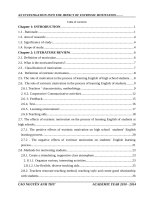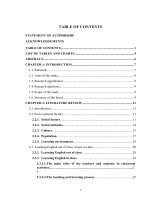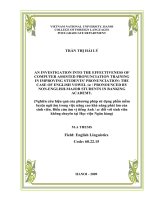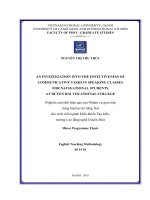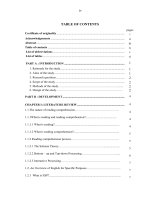An investigation into the impact of context on a vietnamese tertiary level english teachers teaching practices a case study dr
Bạn đang xem bản rút gọn của tài liệu. Xem và tải ngay bản đầy đủ của tài liệu tại đây (2.17 MB, 285 trang )
AN INVESTIGATION INTO THE IMPACT OF CONTEXT ON A VIETNAMESE
TERTIARY LEVEL ENGLISH TEACHER‘S TEACHING
PRACTICES: A CASE STUDY
A Dissertation
Presented to
The Faculty of the Graduate School
Ateneo de Manila University
In Partial Fulfillment
of the Requirements for the Degree
Doctor of Philosophy
By
Nguyễn Quang Tiến
2012
iv
ACKNOWLEDGEMENTS
The writing of this dissertation was truly a journey with many challenges that
came along the way, and the completion of this journey was thanks to many kind and
generous people who constantly helped me to surmount the difficulties.
I am most grateful to Dr. Maria Luz C. Vilches for accepting me as her advisee,
for her guidance, dedication, patience, trust, warm full support, and encouragement all
throughout the process of writing this dissertation.
I also thank my dissertation panel members, Dr. Maria Luisa T. Reyes, Dr.
Margarita R. Orendain, Dr. Marianne Rachel G. Perfecto, Dr. Carolina A. Nuñez, and Dr.
Vũ Thị Phương Anh for their comments and recommendations to enrich my insights.
I would not have been able to accomplish this dissertation without the help of the
following people to whom I give my heartfelt thanks: Dr. Frances L. Hoffmann and Dr.
Vũ Thị Phương Anh for helpful discussions and suggestions; Dr. Isabel Pefianco Martin
and Dr. Beatriz P. Lorente, whose coursework provided me with knowledge of English
language teaching; Ms. Nguyễn Thị Thanh Hà and Mr. Bùi Mỹ Ngọc (University of
Economics, HCMC), Mr. Nguyễn Ngọc Huân (HUFLIT), and Ms. Bùi Thị Thúy Quyên
(University of Economics and Finance) for their support in my data collection; Mr.
Quách Phúc Linh, Ms. Quách Bảo Trân, and Mr. Võ Văn Sang for their taking care of me
in the Philippines and in Vietnam; and Ms. Nguyễn Bích Hạnh for her encouragement.
This work would not have been possible without the grant from the United Board
for Christian Higher Education in Asia (UBCHEA) and the administrative support of the
Office of International Relations (OIR) of the Ateneo de Manila University.
My special thanks go to my family for their care, encouragement and love.
My greatest gratitude goes to God Almighty in whom I live and trust.
v
ABSTRACT
This dissertation examines the impact of context on a Vietnamese tertiary level English
teacher‘s teaching practices. It aims to answer the central question, ―Why does a
Vietnamese English teacher teach the way he/she does in each of two different tertiary
level educational contexts?‖ The research subject was a Vietnamese English teacher
teaching in two different universities. The data mainly came from classroom observations,
stimulated recall interviews, and students‘ written feedback. The general finding was that
while national and institutional contexts (with either BANA1 or TESEP2 norms) set the
general conditions for a teacher‘s teaching practices, the impact of such contexts on the
teacher‘s decision-making processes about what constitutes good English teaching in
actual classroom practice is secondary to the impact of the teacher‘s wealth of
educational training, teaching experience, and dedication to duty in order to meet the
learning needs of students. The teacher‘s teaching practices in these contexts can be
shown in her classroom management styles, lecture styles, and teaching methods – all
creatively adjusted to offset the limitations of context or to enhance the favorable setting
in order to create the desired learning atmosphere.
1
Britain, Australasia, an North America
Tertiary, secondary, and primary English language education in the countries, not
including BANA
2
vi
TABLE OF CONTENTS
Page
ABBREVIATIONS .............................................................................................................x
DEFINITION OF TERMS ................................................................................................ xi
LIST OF TABLES ........................................................................................................... xiii
CHARTS ............................................................................................................................xv
FIGURES ......................................................................................................................... xvi
APPENDICES ................................................................................................................ xvii
I. INTRODUCTION ........................................................................................................01
Background of the Study ................................................................................................01
Historical View of Foreign Language Education in Vietnam ...............................02
Summary .......................................................................................................08
Languages of Vietnam ...........................................................................................09
Ethnic setting ................................................................................................09
Linguistic setting ...........................................................................................10
Summary .......................................................................................................14
English in Vietnam‘s Educational System ............................................................14
Statement of the Problem ................................................................................................16
Scope and Limitations of the Study ................................................................................18
Significance of the Study ................................................................................................18
Language Research Area .......................................................................................19
Teaching-learning Practice ....................................................................................19
Vietnamese Educators and Administrators ............................................................20
Theoretical Framework ...................................................................................................20
Institutional Context...............................................................................................22
TESEP and BANA—two parts of the profession in ELT.............................22
Cultural networks ..........................................................................................25
National cultures ..................................................................................25
Organizational cultures ........................................................................28
Classroom cultures ...............................................................................30
The professional-academic cultures ..............................................................30
Summary .......................................................................................................33
Sociocultural Interaction (Vygotsky, 1978) ...........................................................33
Zone of Proximal Development (ZPD).........................................................34
Scaffolding ...................................................................................................36
Conceptual Framework ...................................................................................................37
Summary .........................................................................................................................39
vii
II. METHODOLOGY .....................................................................................................41
Research Question #1 ..................................................................................................42
Vietnam‘s English Language Policies ...................................................................43
Current Teaching and Learning English in Vietnam‘s Educational System .........47
ELT Context in Two Universities Where the Present Study Was Conducted .......48
General contexts............................................................................................49
Context in detail ............................................................................................50
Curricula ..............................................................................................50
Foci in the curriculum ..............................................................52
Number of hours for English study..........................................52
English class size .....................................................................54
Materials and use of supplementary materials .........................54
Following the curriculum framework of the MOET................55
Placement tests .........................................................................55
Exit English language exams ...................................................56
Syllabi ..................................................................................................56
Syllabus of Class KT 79 in UEH .............................................56
Syllabus of Class SE 2.3 in UEF .............................................56
Objectives of the course .......................................................................57
Lesson plans .........................................................................................57
Facilities ...............................................................................................57
Equipment ................................................................................57
Students‘ tables and benches ...................................................57
Teaching quality assurance ..................................................................58
Classroom observations ...........................................................58
Periodic teacher evaluation and student feedback ...................58
Teachers‘ meetings ..................................................................59
Quality assurance office ...........................................................59
Administrative matters .........................................................................59
Curriculum management ..........................................................59
Tuition fee ................................................................................60
Teaching remuneration ............................................................60
Students‘ profiles .................................................................................60
Teacher‘s profile ..................................................................................61
Research Question #2 ..................................................................................................61
Locales of the Study...............................................................................................61
Time for Classroom Observations .........................................................................62
Observed Classes ...................................................................................................62
Case Study Subject ................................................................................................62
Non-participant Observers .....................................................................................62
Instruments for Observations .................................................................................63
Observation Focus Points ......................................................................................63
More about Questioning Strategies ........................................................................64
The Analysis of Questioning Strategies .................................................................65
Transcriptions ........................................................................................................67
viii
Students‘ Feedback on the Observed Classes ........................................................67
Research question #3 ...................................................................................................68
The Gap between the Observation Sessions and the Stimulated Recall
Interviews ......................................................................................................69
Procedures of the Stimulated Recall Interviews ....................................................70
Stages of Data Analysis .........................................................................................72
Ethical Issues .........................................................................................................72
Quality Control Issues............................................................................................76
Summary ......................................................................................................................78
III. LITERATURE REVIEW .........................................................................................81
Recent Reviews and Studies on the Current ELT in Vietnam‘s Educational
System in General .........................................................................................81
Lack of English Teachers.......................................................................................81
Big Class Size ........................................................................................................81
Low Educational Cost, Low Tuition Fee, Teacher‘s Low Remuneration,
and Low Quality Teaching and Learning .....................................................82
Students‘ Low Entrance English Level ..................................................................82
Limited Length of Time for English Learning ......................................................83
The Interplay between Students‘ Level of English and Class Time ......................83
Students‘ Heterogeneous English Levels...............................................................83
Foci in English Learning and Teaching .................................................................84
Foci in English Assessment ...................................................................................84
Waste of Time, Money, and Efforts in English Learning and Teaching ...............84
Time for English Learning .....................................................................................84
Percentage of Students Who Meet the Required Level of English
Communication .............................................................................................85
Overview of Research-based studies ...........................................................................85
Separate Research-based Studies .................................................................................86
Han‘s (2007) Study
Hawkey‘s (2006) Study
Littlewood‘s (2001) Study
Wu‘s (1995) Study
Lai‘s (1994) Study
Kumar‘s (1992) Study
Summary ......................................................................................................................96
IV. ENGLISH TEACHING PRACTICES UNDER CERTAIN CONDITIONS ......98
General Observations ...................................................................................................98
Classroom Interaction ............................................................................................98
Participation organization .............................................................................98
Interactive styles .........................................................................................100
Teacher questions............................................................................100
Teacher-student interaction .............................................................101
ix
Interaction time ...............................................................................102
Time distribution for all activities..........................................104
The Relationship between teacher talk time and
the number of teacher questions ..........................104
The relationship among the number of teacher questions,
wait time, and the number of teacher questions
answered by the students .....................................105
Teacher‘s giving answers to her own questions in relation
to wait time ..........................................................105
Teaching Methods ................................................................................................106
Teaching styles............................................................................................106
Use of the mother tongue ............................................................................107
Analysis......................................................................................................................108
Time Constraint and Class Size ...........................................................................109
Seating Arrangements in Relation to Class Size..................................................112
Teaching Content in Relation to Time Constraint ...............................................114
Students‘ Levels of English and Target Objectives in the English Programs .....122
Teacher Evaluation System..................................................................................127
Cultural Factors ....................................................................................................132
Students‘ Preference in Teacher-student Interaction ...........................................135
Technical Support ................................................................................................136
Challenges Which Brought out Solutions ............................................................137
Teacher Cognition ................................................................................................145
Summary ....................................................................................................................146
V. CONCLUSIONS, IMPLICATIONS, AND RECOMMENDATIONS ................147
Conclusions ................................................................................................................147
The Conditions Which Had Impacts on the Teacher‘s Teaching Practices .........147
Gains from the Present Study ..............................................................................155
Summary ..............................................................................................................158
Implications................................................................................................................159
Language Research Area .....................................................................................159
Teaching-learning Practice ..................................................................................159
Vietnamese Educators and Administrators ..........................................................161
Development of the English Language in Vietnam .............................................162
Recommendations ......................................................................................................164
REFERENCES ................................................................................................................166
FOOTNOTES ..................................................................................................................176
APPENDICES .................................................................................................................178
x
ABBREVIATIONS
AFTA
:
Asia Free Trade Area
ALTE
:
The Association of Language Testers of Europe
APEC
:
Asia Pacific Economic Group
ASEAN
:
Association of South East Asia Nations
BANA
:
Britain, Australasia, an North America
CEF
:
Common European Framework
CLT
:
Communicative Language Teaching
COLT
:
Communicative Orientation of Language Teaching
COMECON :
Communist Economic Trading Block
DRV
:
Democratic Republic of Vietnam
EFL
:
English as a Foreign Language
ELT
:
English Language Teaching
ESL
:
English as a Second Language
ESP
:
English for Specific Purposes
ETS
:
Educational Testing Service
HCMC
:
Ho Chi Minh City
IELTS
:
International English Language Testing System
MOET
:
Ministry of Education and Training
TESEP
:
Tertiary, secondary, and primary English language education in the
countries, not including BANA
TESOL
:
Teaching English to Speakers of Other Languages
TOEFL
:
Test of English as a Foreign Language
TOEIC
:
Test of English for International Communication
UEF
:
University of Economics and Finance, Ho Chi Minh City
UEH
:
University of Economics, Ho Chi Minh City
xi
DEFINITION OF TERMS
Behavior is any activity of an organism that can be either directly or indirectly observed
(Powell et al., 2002, p. 3).
Classroom behavior refers to teachers‘ and/ or students‘ observable activities.
Classroom observation refers to a set of related procedures for gathering data in the
classroom.
Context is defined as a national and/ or institutional setting that is comprised of elements
such as educational policies, styles of management, classroom settings, curricula, syllabi,
teachers, and students.
General pedagogical knowledge denotes general knowledge about teaching, including
beliefs and skills related to general principles of curriculum and instruction, learners and
learning, and classroom management (Shulman, 1986).
Impact is the effect of something on something else (Hornby, 2005).
Input refers to the language that is addressed to the L2 learner (Gebhard & Oprandy,
1991, p. 53).
Interaction consists of the discourse jointly constructed by the learner and his
interlocutors (Philippson & Skutnabb-Kangas, 1996).
Language policy is a broad, overarching term for decisions on rights and access to
language (Gebhard & Oprandy, 1999, p. 38).
Overt behavior is behavior being directly observed by an individual other than the one
performing the behavior (Powell et al., 2002, (p. 48).
Participant observer is the one who plans to be involved with a class. The action of the
participant observer is added to a video or audio recording of a class in order to elicit
xii
verbal commentaries about the cognitions which are typically thoughts or decisionmaking processes (Borg, 2006, 209; Nunan & Bailey, 2009, p. 259).
Participation refers to taking part in an observable activity.
Question asking is defined as one of the basic ways by which the teacher stimulates
student thinking and learning (Gall, 1970, p. 707).
Rephrasing in the present study refers to using different syntactic structures to provide
comprehensible input to language learners.
Semi-structured interviews are open-ended and less rigid than structured interviews, thus
providing much greater flexibility to the researcher (Allwright & Bailey, 1991, p. 62;
Burns, 1999, pp. 120 – 121).
Stimulated recall interview, as the name suggests, is a procedure by which a researcher
stimulates the recollection by a participant of an event. This is done by having that person
review data collected during the event (Nunan & Bailey, 2009, p. 259).
Teacher cognition is an unobservable cognitive dimension of teaching, which includes
what teachers think, know, and believe. It is reflected in teachers‘ decision making (Borg,
2003, 2006).
Teaching practices refer to teachers‘ application of teaching strategies, teaching
techniques, or teaching methods.
Transcripts are written records of interaction wherein one can read the researcher‘s
verbatim notation of information (Wu, 1995).
xiii
LIST OF TABLES
Page
No.
Chapter I
1.1
Two Parts of the Profession in ELT (culled from Holliday, 1994) ..............................
23
1.2
Categories of National Cultures and the Behaviors with Them (Hofstede,
1991).............................................................................................................................
26
1.3
Three Different Types of Organizational Cultures (culled from
Trompenaars, 1993) .....................................................................................................
29
1.4
Collection and Integration (culled from Holliday, 1994) .............................................
32
Chapter II
2.1
Brief Summary of Methodology ..................................................................................
41
2.2
Sources of Data for Research Question #1...................................................................
42
2.3
English Language Learning and Teaching Plan in Vietnam for 2008-2020 ................
44
2.4
ELT Context in the Two Universities Where the Present Study was
Conducted.....................................................................................................................
51
2.5
Types of Teacher Questions .........................................................................................
64
2.6
Questioning Strategies Used by the Teacher ................................................................
66
2.7
Stimulated Recall Interview Guidelines .......................................................................
69
2.8
Procedures of Stimulated Recall Interviews ................................................................
71
2.9
Stages of Data Analysis ................................................................................................
73
79
2.10 Detailed Methodology in Line with Three Research Questions ..................................
Chapter IV
4.1
Details of Pair Work, Group Work, and Individual Work ...........................................
99
4.2
Types of the Teacher‘s Questions and Questioning Strategies ....................................
101
4.3
Teacher-student Interaction ..........................................................................................
102
xiv
4.4
Interaction Time in the Observed Classes ....................................................................
103
4.5
Number of Questions and Teacher Talk Time .............................................................
104
4.6
Number of Questions, Wait Time, and Number of the Teacher‘s Questions
Answered by the Students ............................................................................................
105
4.7
Teaching Styles ............................................................................................................
106
4.8
Use of L1 ......................................................................................................................
108
4.9
Students‘ Feedback on Use of Languages in Class ......................................................
119
126
4.10 Reasons for the Students‘ Preference of Length of Responses ....................................
xv
CHARTS
No.
Page
1.1
Stages of Language Planning and Policy in Vietnam (Nguyen Quang Tien,
2011) .........................................................................................................................03
xvi
FIGURES
Chapter I
Page
1.1
Interplay among Three Components in Language Teaching ..................................
21
1.2
Conceptual Framework ...........................................................................................
40
xvii
APPENDICES
Chapter I
Page
1A
A List of Countries Which Give English Some Official Function .........................
178
1B
Ethnic Composition of Vietnam (as of 1994) (Vasavakul, 2003) ...........................
179
1C
Language Families, Ethnic Groups, Population Size, and Writing
System of Vietnam (as of 1994)..............................................................................
180
1D
Vietnam‘s Educational System ...............................................................................
182
Chapter II
2A
Teachers‘ Quotes in Vietnamese and English Translations ....................................
183
2B
ALTE – The Association of Language Testers of Europe .....................................
184
2C
Curriculum at UEH .................................................................................................
187
2D
Syllabi of UEH and UEF ........................................................................................
189
2E
The Main Textbooks in UEH and UEF ..................................................................
192
2F
Students‘ Questionnaire on Self-Evaluation and Demographic
Information ..............................................................................................................
198
2G
Summary of The Students‘ Background Information in UEH and
199
UEF .........................................................................................................................
2H
Teacher‘s Profile .....................................................................................................
201
2I
Observation Sheet ...................................................................................................
202
2J
Duff‘s (1996) Transcription Conventions & Ellis‘s (1985) ....................................
204
2K
Students‘ Feedback Form........................................................................................
206
2L
Summary of the Students‘ Feedback on the Observed Classes ..............................
207
2M
Instruction of the Stimulated Recall Interviews ......................................................
209
xviii
2N
Letter of Invitation to Participate in the Research (For Students) ..........................
210
2O
Letter of Invitation to Participate in the Research (For Teacher) ...........................
211
Chapter IV
4A
Actual Happenings in the Classroom ......................................................................
212
4B
Detailed Teaching Content......................................................................................
213
4C
Teacher‘s Quotes in Vietnamese and English Translations ....................................
222
4D
Tapescripts ..............................................................................................................
226
4E
Code-switching .......................................................................................................
268
Chapter V
5A
English-Vietnamese Code-switching (Ho Dac Tu, 2003).......................................
274
CHAPTER I
INTRODUCTION
Background of the Study
It is obvious that English has become a lingua franca in the world (Crystal, 2003;
Kachru, 1998, 2005; Kirkpatrick, 2002; Oka, 2004; Phan, 2005; Seidlhofer, 2005). It has
developed into a dominant language in English mother-tongue countries and into official
or semi-official languages in the countries that are former colonies of the United States or
Britain (Mckay, 1992, p. 28). Lowenberg (1989, p. 216) provides a list of countries that
give English some official function (Appendix 1A). In addition, English is also used in
many formerly-francophone countries like Tunisia, Vietnam and Cambodia. These
countries are without any British or US colonial influence (Spolsky, 2006, p. 79).
Nevertheless, the study of foreign languages, especially English, is increasing in these
countries. This fact confirms Spolsky‘s statement that the more speakers a language has,
the more people want to learn it (Spolsky, p. 89). This statement is true for the situation
of Vietnam. Since after the Sixth National Congress of the Vietnamese Communist Party
(1986), which launched ‗Open-Door‘ or ‗Doi Moi‘ (renovation) policy with the aim to
expand the country‘s international communication, particularly with neighboring
countries like Singapore and Thailand, there has been a remarkable development in the
practices of learning and teaching English in Vietnam. English training has been in great
demand in the aforementioned country since then.
This section situates the emergence of English in Vietnamese society within the
history of the country‘s languages and foreign language education practices in order to
2
facilitate a greater understanding of the current state of learning and teaching English in
the above context. This section also presents briefly the place of English in the spectrum
of Vietnamese languages, and in Vietnam‘s contemporary educational system. All of
these are done in order to provide a background to the central issue that the present study
is aimed at: an examination of the impact of ELT contexts on teachers‘ classroom
teaching practices.
Historical View of Foreign Language Education in Vietnam
Like the other countries in the region, Vietnam is under the influence of a
globalized economy, which has brought about numerous changes in the country‘s politics,
economics, education, and cultures. These changes have, to some extent, led to the
changes in the country‘s foreign language education policy. In order to understand how
Vietnam‘s history has influenced its foreign language education policy, this section
historicizes Vietnam from the time it was still occupied by the Chinese until the time it
was independent of foreign rule. The review serves as background information for
understanding the rest of the section.
The language policy of Vietnam has been reviewed by a number of researchers
(Denham, 1992; Do, 1999; Do, 2006b; Nguyen & Nguyen, 2007; Vasavakul, 2003; Vu,
1997; Wright, 2002). Based on the discussions of these researchers, this section aims to
provide a compact view of the linguistic setting in Vietnam with a reader-friendly chart
(see Chart 1.1). The development of the language policy in Vietnam has gone through six
stages: (1) Vietnam from 111 BC to 938 AD, (2) Vietnam independent of Chinese rules,
(3) French colonization (1867 – 1954), (4) American colonization (1955 – 1975), (5)
Decolonization (1975 – 1986), and (6) ‗Open-door‘ policy (since 1986).
3
Chart 1.1. Stages of Language Planning and Policy in Vietnam (Nguyen Quang Tien, 2011)
Chinese
reigns
111
BC
938
AD
Chinese
French
colonialization
Civil strife
13th
C
16th
‘Nom’
developed
17th
18th
Quoc-Ngu
(National
Language)
1867
1919
Quoc-Ngu Chinese
banned
French
French
war
Ame.
war
‘Doi
Moi’
1945-54
1955-75
1986
Chi, Fr, E
DISAPPEARED
2011
Many FLs
promoted
Russian
promoted
Chi, Fr, E
Promoted
1,000
Under
Chinese
rules
STAGE 1
From 10th-17thC
Vietnam
INDEPENDENT
STAGE 2
Almost
100 years
under
French
colonialization
STAGE 3
20 years
under
the USA
Russian
Less in demand
STAGE 6
STAGE 4
STAGE 5
4
Stage 1: Vietnam from 111 BC to 938 AD. The history of Vietnam can be traced
back to 111 BC, when Vietnam was under Chinese rule. This would last until 938 AD
(Denham, 1992; Nguyen & Nguyen, 2007; Vasavakul, 2003; Wright, 2002). During the
Chinese colonization, a Chinese system of schools was created to train both Chinese and
Vietnamese children, particularly those of the Chinese and Vietnamese aristocracy
lineage. So the education during that time was conducted in Chinese, and followed
Chinese models, specifically the Chinese methodology and the competitive examination
system. From the perspective of language implementation, defined by Kaplan & Baldauf
Jr., (1997) and Ridge (1996) as the decision, the adoption and spread of the language
form that has been selected, the Chinese language was the first foreign language used and
spoken in Vietnam over the period of almost 1,000 years.
Stage 2: Vietnam from 939 to the first half of the 18thcentury. In 939 AD,
Vietnam became independent from China. However, the Chinese influence remained
very strong. Formal education was conducted in Chinese, the language of the state;
Chinese textbooks and a system of competitive examination were still used. In the 13th
century, scholars developed Nom, a script for the Vietnamese language based on Chinese
characters. While Nom was the language for ordinary Vietnamese people, classical
Chinese was used for legal documents and spoken in royal families.
From the 16th century to the mid 18th century, Vietnam underwent civil strife. Due
to this civil turmoil, European missionaries (Dominicans, Franciscans, and the Jesuits)
were able to enter Vietnam. One remarkable thing about this period is that Quoc Ngu
(National language)—Romanized Vietnamese—was invented in the 17th century by
Alexandre de Rhodes, a French Jesuit missionary. Quoc Ngu is the Vietnamese language
5
today. In brief, stage two is marked by two events: (1) the invention of Nom based on
Chinese characters in the 13th century for Vietnamese ordinary people, and (2) the
invention of Quoc Ngu in the 17th century. Though these two languages were developed
in this period, Chinese was still in use (Vasavakul, 2003).
Stage 3: French colonization (1867 – 1954). French colonization in Vietnam
lasted for almost one hundred years. That is, in 1867 Vietnam, given the name
‗Cochinchina‘, became a French colony. This colonization lasted for almost one hundred
years. Vietnam was not liberated from the French until 1954. By 1878, only Quoc Ngu
and French were permitted in official documents. Thus, French was the second foreign
language officially used in Vietnam. In 1919, Chinese education was officially banned in
the colony. In brief, stage three is marked by the fact that French became the second
foreign language of Vietnam (Vasavakul, 2003).
Stage 4: American colonization (1955 – 1975). In 1954, the Geneva Conference
divided Vietnam into two parts in the context of the Cold War: North and South. The
Communist regime of Ho Chi Minh controlled the North while the American-backed
regime controlled the South. This division lasted from 1955 to 1975. During this period,
the North was greatly supported by China and Russia. Because of this the learning and
teaching of Chinese and Russian were promoted in the North, whereas French and
English were not. In the South, which was backed up by the Americans, English language
learning and teaching was promoted. These political events affected the language policy
in Vietnam during that time. That is, Russian and English became the two foreign
languages learnt and taught in Vietnam after Chinese and French. In brief, by 1975, four
6
foreign languages—Chinese, French, Russian, and English—were being spoken in
Vietnam.
Stage 5: Decolonization period (1975 – 1985). In 1975, Vietnam was re-unified.
Afterwards, a key national goal was to eliminate the enslaving ―decadent culture that
destroys the old and beautiful traditions of the Vietnamese people‖ (Terzani, 1997, p.
176). English and French were considered two carriers of this decadent culture. Both of
these disappeared from the educational system and from the Vietnamese learners‘
linguistic repertoire (Wright, 2002) since they were regarded as ‗enemy languages.‘ In
1979, because the war broke out between China and Vietnam along the border between
the two countries, Chinese was considered an ‗enemy language,‘ and it was banned
afterwards. During this time, the use of the three foreign languages—Chinese, French,
and English—almost disappeared. Only Russian was still accepted since Vietnam was
economically and educationally supported by Russia.
Stage 6: Period of ―Doi Moi‖ policy (―Open-door‖ or ―Renovation‖ policy)
from 1986. Because it isolated itself from other countries after the liberation in 1975, the
economy of Vietnam stagnated. In 1986, influenced by Russia and Gorbachev‘s
economic reform, Vietnam changed its policy and opened its door to the world. The ―Doi
Moi‖ (―Open-Door‖/ ―Renovation‖) policy is known as one of the major breakthroughs
or changes made in 1986. This change in economic policy meant that Vietnam was
involving itself in globalization by getting direct investments from other countries
(Wright, 2002). During this time, Russian was still popularly promoted and taught in
schools, as Vietnam was still economically reliant on COMECON (the Communist
economic trading block). This reliance on the COMECON lasted until 1991, when the
7
Soviet Union block collapsed. As a consequence of this, trade and aid relationships
stopped and the Russian language quickly disappeared in Vietnam.
The paradigm shift in language policy and the factors influencing this shift.
As attested to by each stage above, the emergence or disappearance of a foreign language
in Vietnam‘s history is associated with macro-sociopolitical factors. Between 1975, when
Vietnam was re-unified, to 1985 (ten years of liberation), all foreign languages except
Russian were considered ‗enemy languages.‘ The Vietnamese were not encouraged to
study these languages and they seemed to disappear from Vietnamese learners‘ linguistic
repertoire (Wright, 2002) partly because the Government feared that exposure to these
foreign languages would influence Vietnamese to be ―Western‖ or ―decadent.‖
Multilingualism was seen as a problem.
After 1986, there was a new pragmatic view of both language and linguistic
instrumentalism in Vietnam. Capital from Asian countries like Taiwan and Hong Kong,
and from European countries like Switzerland and France, flowed into the country;
Vietnam was also admitted into the ASEAN (Association of South East Asian Nations) in
1995. Diplomatic relationships with the United States were eventually normalized, and
Vietnam also became a member of AFTA (Asia Free Trade Area) and APEC (Asia
Pacific Economic Group).
These changes in economic relationships have been the driving forces in
Vietnam‘s paradigm change in language policy. The three foreign languages (Chinese,
French, and English) that were seen as ‗enemy languages‘ and ignored before 1986 were
again promoted to allow Vietnam to catch up with the economic growth in the region. In
the new globalized economy, Vietnam began to acknowledge the importance of
8
multilingual communication. In other words, multilingualism and foreign language
learning were promoted. The notion of ‗enemy languages‘ gradually disappeared in
Vietnam. The government and the citizens realized the important role of foreign
languages in the globalized new economy that Vietnam had started to get involved in.
This shift was seen in the fact that from 1985 to 1993, around 200 Vietnamese teachers of
English were sent to Australia for higher education, while some others were sent to
Britain and India (Do, 1999). The paradigm shift in language policy was also affected by
the collapse of the Soviet Union in 1991. As mentioned earlier, the Soviet Union block
was a great economic support for Vietnam after the reunification of 1975. After the
collapse, Vietnam ceased to receive aid from this union. Consequently, the learning and
teaching of Russian became less in demand afterwards.
The paradigm shift regarding the view of foreign language learning significantly
changed after 1986. In the past few years, the Vietnamese government as well as
Vietnamese educators have been more concerned about the quality of learning and
teaching foreign languages in Vietnam, particularly that of English because it serves as a
tool for international communication and for the development of Vietnam, which has just
become a member of the ASEAN, AFTA, and APEC, where English is used as the
official working language. According to Vu (1997, p.11), no other foreign language could
serve international communication better than English in Vietnam. Thus, English has
become the dominant official foreign language in the Vietnamese people‘s linguistic
repertoire and in Vietnam‘s education system.
Summary. In brief, this section has presented a historical perspective of foreign
language education in Vietnam from the time when Vietnam was under the Chinese reign
9
until the present day. Chinese was spoken and taught during the period of Chinese
colonization; Nom, a language invented in the 13th century, was based on Chinese
characters for ordinary Vietnamese people; Quoc Ngu, the Romanized national language,
was invented in the 17th century by a French Jesuit missionary; French was spoken during
the French colonization (1867 – 1954); during the Vietnam War (1955 – 1975), Chinese
and Russian were promoted in North Vietnam while English and French were promoted
in South Vietnam. The decolonization period lasted from 1975 – 1985; during this time,
Chinese, French, and English were seen as ―enemy languages,‖ while Russian was
considered acceptable. From the time when the ―Doi Moi‖ (―Open-door‖) policy was
implemented until now, many foreign languages (English, French, Italian, Spanish,
Chinese, Korean, and Thai, to name just a few) have been promoted in the country.
A perspective of foreign language education in Vietnam has just been presented in
order to identify the status of the English language in Vietnam from the Vietnam War
(1955) until now. This status will be more clearly seen when viewed within the broad
picture of the languages of Vietnam that were discussed by Vasavakul (2003). In this
picture, the author describes the ethnic setting as well as the linguistic setting in Vietnam,
and shows the status of the English language among many other languages of ethnic
minorities. The picture of the languages of Vietnam is presented below.
The Languages of Vietnam
Ethnic setting. In order to understand the linguistic setting in Vietnam that will
be presented later in this section, it is necessary to look at the ethnic setting in the country
described by Vasavakul (2003).




